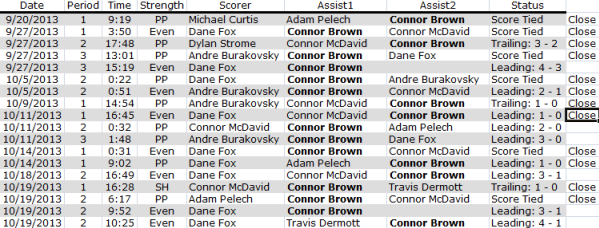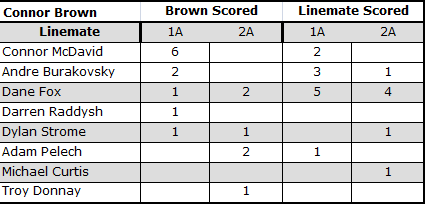The Toronto Maple Leafs have two players ranked among the top-5 in Ontario Hockey League scoring.
The Erie Otters captain Connor Brown, is in his second season post draft, selected in the 6th round in 2012 (156th overall). The 6-foot-1 winger lines up with arguably the best player in the Canadian Hockey League in Connor McDavid and currently leads the OHL in scoring, holding steady to a two point lead over the Niagara IceDogs leading scorer, Brendan Perlini.
(Note*** stats are as of October 24, 2013. Games played on October 25, 2013 have not been added. Stats have been compiled using the CHL stats pages that have yet to be updated for 2013-14 as we tweak and add new features. The pages from 2012-13 are located here.)
One degree of separation from Perlini is teammate Carter Verhaeghe ranked third in scoring. The center was drafted in the 3rd round in 2013 (82nd overall). Niagara travels to Oshawa on Sunday Oct 26, and the plan is to attend the game for more detailed notes early next week. This post concentrate more on the numbers than scouting.
Brown was profiled in an early season appearance through Mississauga here.
Let’s start with a summary table.
Both players have been on the ice for over 30% of the team goals and less than 10% of team goals against.
Using the method described here by Eric Tulsky, we can approximate their average time by adding up the total goals and using that a proxy for total ice time, then down to per game basis. Brown averaged around 24 minutes and Verhaeghe close to 26 minutes.
I didn't calculate the quality of competition/teammates, but it's a safe assumption that players getting that much ice time are likely to be facing the best opponents and defensive pairings on a nightly basis. Teammates will be addressed somewhat below.
Both players have scored almost half their points at even strength with a positive differential for on ice goals for and against at even strength.
For example, Brown was on the ice for 19 goals and 11 goals against, giving a ratio of 1.73 (ESGF/ESGA). For Verhaeghe, this ratio is 1.42 and the average in the OHL, among regulars with a minimum 10 games played is 1.18.
To further isolate players likeliest to receive the most time on ice for their respective teams, I took the overall list of players and filtered for players above the average of 1.18. When using that group, the average of the remaining players changes to 1.94.
While the differentials against the entire sample is higher, among the players with presumably the most ice time in the OHL, both players are under the average.
Let’s look at the breakdown of goals.
GOALS
Brown has 11 goals, with nine in games with the score ‘close’ in which are the same parameter definitions as those for the NHL are used. The game ‘close’ is when the score is tied or within one goal in the first two periods and tied in the third period.
Nine of Brown’s 11 goals have come in game close situations. His goals in general are evenly split among periods (4-4-3), with six courtesy of a McDavid first assist - and slightly over half courtesy of the powerplay. The two goals that weren’t scored in close situations, both came in the third period, one to extend a lead and the other an empty net marker when up by two goals. The key here is being on the ice late in the game defending a late lead with the opposition’s goalie pulled. Brown also gets time on ice in special teams (one assist as a penalty-killer).
Of Carter Verhaeghe’s 10 goals, nine were scored with games close.
Scoring out of the gate strong is the theme here, with seven (7) goals in the first period, two in the second and a lone third period marker with the IceDogs trailing 3-2 to tie the game and pull even (Belleville would win this game on a powerplay marker with only 13 seconds left to play in regulation.) Just less than half of his goals were via the powerplay.
ASSISTS
Brown’s assists accumulations have similarities in that 12 of his 18 assists or two-thirds came via games ‘close’ situations.
For Verhaeghe, nine of his 15 assists (60%) were in games close, with four secondary assists allocating 73% of his 2013-14 assists as primary.
POINTS SPLITS
One last breakdown to differentiate is point splits garnered through their teammates.
Immediately jumping out is the connection for Brown converting in McDavid passes and playing the role of playmaker to undrafted overager, Dane Fox and assisting on half of Andre Burakovsky’s goals.
For Verhaeghe, he splits playmaking and goal scoring with Perlini, with more emphasis on the first assists in both instances.
(The highlighted rows were just a function of Microsoft Excel and don't have any hidden meaning, I just didn't change the coloring in the original table.)
While this is the statistical look at these players, stay tuned for an in depth scouting report of Sunday's game for Verhaeghe.
**********
I might do more of these and have them come under the title of Kats Stats. Something to ponder.
**********
Follow the McKeen's team on Twitter:





































